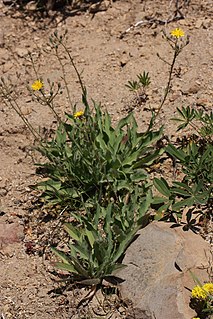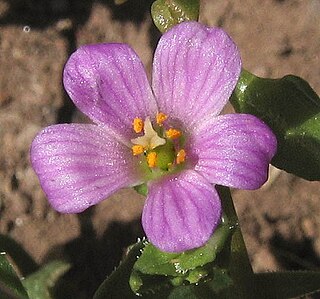
Hieracium , known by the common name hawkweed and classically as hierakion, is a genus of flowering plant in the family Asteraceae, and closely related to dandelion (Taraxacum), chicory (Cichorium), prickly lettuce (Lactuca) and sow thistle (Sonchus), which are part of the tribe Cichorieae. Hawkweeds, with their 10,000+ recorded species and subspecies, do their part to make Asteraceae the second largest family of flowering plants. Some botanists group all these species or subspecies into approximately 800 accepted species, while others prefer to accept several thousand species. Since most hawkweeds reproduce exclusively asexually by means of seeds that are genetically identical to their mother plant, clones or populations that consist of genetically identical plants are formed and some botanists prefer to accept these clones as good species whereas others try to group them into a few hundred more broadly defined species. What is here treated as the single genus Hieracium is now treated by most European experts as two different genera, Hieracium and Pilosella, with species such as Hieracium pilosella, Hieracium floribundum and Hieracium aurantiacum referred to the latter genus. Many members of the genus Pilosella reproduce both by stolons and by seeds, whereas true Hieracium species reproduce only by seeds. In Pilosella, many individual plants are capable of forming both normal sexual and asexual (apomictic) seeds, whereas individual plants of Hieracium only produce one kind of seeds. Another difference is that all species of Pilosella have leaves with smooth (entire) margins whereas most species of Hieracium have distinctly dentate to deeply cut or divided leaves.
A dry roadside dotted with small, ¾ inch red orange flowers, interspersed with very similar yellow ones, and often the white of daisies, is a good sign that you are in Hawkweed country.

Ribes sanguineum, the flowering currant, redflower currant, red-flowering currant, or red currant is a North American species of flowering plant in the family Grossulariaceae, native to the western United States and Canada.

Pilosella caespitosa is like several other Pilosella species and has a similar appearance to many of the hawkweeds.

Hieracium albertinum, known as western hawkweed or houndstongue hawkweed, is a species of the genus Hieracium that is very similar to Hieracium albiflorum with white flowers but differs in that the flower heads are clustered and the leaves, stems and bracts are covered in a thick layer of hairs. Standing 1 inch (3 cm) to 5 inches (13 cm) tall, it can be found blooming from June through August in forest clearings.

Dudleya blochmaniae is a summer-deciduous succulent plant known by the common names Blochman's liveforever or Blochman's dudleya. This species of Dudleya survives part of the year with no aboveground presence, surviving as underground corm-like roots in deciduous months. It is characterized by white, star-shaped and spreading flowers that emerge after sufficient rainfall. It is found along the Pacific coast of the California Floristic Province, from the vicinity of San Luis Obispo in California to Punta Colonet in Baja California.

Pilosella scouleri is a North American species of flowering plant in the tribe Cichorieae within the family Asteraceae. It is known as Scouler's woollyweed. It is native to western North America, from British Columbia and Alberta in Canada, south to northern California and Utah in the United States.

Jepsonia parryi is an uncommon species of flowering plant in the saxifrage family known by the common names coast jepsonia and Parry's jepsonia. It is a small geophytic plant that flowers briefly during fall, and often only has a single leaf that may appear above the ground after or during flowering. It is native to the coast and inland hills chaparral of southern California and Baja California.

Alisma lanceolatum is a species of aquatic plant in the water plantain family known by the common names lanceleaf water plantain and narrow-leaved water plantain. It is widespread across Europe, North Africa and temperate Asia. It is naturalized in Australia, New Zealand, Oregon, California and British Columbia. It is considered a noxious weed in some places.

Agoseris grandiflora is a North American species of flowering plant in the family Asteraceae known by the common names California dandelion, bigflower agoseris, and grassland agoseris.

Arnica fulgens is a species of arnica known by the common names foothill arnica and hillside arnica. It is native to western North America, from British Columbia east to Saskatchewan and south as far as Inyo County, California, and McKinley County, New Mexico. It grows in open, grassy areas.

Artemisia nova is a North American species of sagebrush, known by the common name black sagebrush. It is "one of the most common shrubs in the western United States".

Calandrinia breweri is a species of flowering plant in the family Montiaceae known by the common name Brewer's redmaids.
Liatris cymosa, also known as Aggie-land gayfeather or branched blazing star, is a plant species in the family Asteraceae and genus Liatris. It is native to east central Texas in North America, where it is found in habitats such as post oak woodlands, fields, fence rows, woodland openings and edges, in clay soils. It blooms in mid to late summer with purple flower heads. It is of conservation concern due to habitat loss.

Nitrophila mohavensis is a rare species of flowering plant in the family Amaranthaceae known by the common name Amargosa niterwort. It is endemic to Nye County in southwestern Nevada and Inyo County, in eastern California.

Arnica dealbata is a species of Californian plants in the tarweed tribe within the aster family

Dittrichia graveolens, commonly known as stinkwort or stinking fleabane, is a plant species in the sunflower family, native to southern Europe, North Africa, and western Asia as far east as Pakistan. It has become naturalized in California, Asia, Africa, Australia, and other places and is regarded as a noxious weed in some regions. It is a classified as an invasive species in California, and a potential threat to wine production in the state.
Calochortus westonii, common name Shirley Meadow star-tulip, is a rare endemic plant known only from the Greenhorn Mountains range of the southern Sierra Nevada, within Kern and Tulare Counties, California.
Hieracium bolanderi or Bolander's hawkweed is a North American plant species in the tribe Cichorieae within the family Asteraceae. It is found primarily in the mountains of western Oregon and northern California in the United States, although there are reports of the species farther south in the San Bernardino Mountains in southern California and also in Baja California in Mexico.
Hieracium nudicaule is a North American plant species in the tribe Cichorieae within the family Asteraceae. It grows only in the western United States, primarily in California and Oregon, though with a few populations in Washington and northern Idaho.

Hieracium scabrum, the rough hawkweed, is a North American plant species in the tribe Cichorieae within the family Asteraceae. It is native to eastern and central Canada and the eastern and central United States from Nova Scotia west to Ontario, Minnesota, and Kansas south as far as Georgia and Oklahoma.














